Discover all your Blue Diamond Discus care essentials in this comprehensive guide. This article covers everything from tank setup to breeding so you can become the ideal Discus hobbyist in no time!

Hop in; let’s take a mind-blowing dive into this Blue Diamond Discus overview.
When the conversation points towards a vibrant and captivating freshwater fish highly regarded among the Discus enthusiasts, the Blue Diamond Discus is a top mention, which is not a coincidence.
The eye-catching brilliant iridescent blue coloration is an instant attention grabber in any tank, coupled with this freshwater fish’s peaceful nature around other similar-sized freshwater creatures and suitability for dedicated aquariums.
In our carefully and craftily curated aquarium guide for Blue Diamond Discus, we’ll help you learn about Discus tank setup, feeding, breeding process, compatibility with other tank mates, and, most importantly, freshwater Discus care.
See also: Top 15 Stunning Discus Fish Types for Your Aquarium, to learn of even more Discus varieties.
Understanding the Appearance of Blue Diamond Discus

On first sighting, the unique discus characteristics, including a solid blue body with sharp, distinctive markings, will steal your gaze.
The sharp blue detail results from selective breeding based on mating wild-caught Blue diamond specimens with the sharpest color to continue a long line of vibrant blue discus fish.
This Malaysian native freshwater breed is unique, with thin oval bodies and elongated fins. Blue Diamond Discus’s appearance has made it one of the more prominent freshwater species purchased by hobbyists for aquariums.
Size: Blue Diamond Discus can grow up to 8 inches for average adults.
Ideal Tank Setup for Blue Diamond Discus
To achieve a successful aquarium setup for blue discus, you need a spacious tank with stable water flow and a sufficient filtration system to keep your water clean and toxins-free.
Blue Diamond Discus prefer to live in groups, which means they need a large tank with ample space to thrive and go about their activities without exposing them to stress or substandard water parameters.
But not to worry—the ideal discus tank conditions are listed below to make housing your freshwater pets easy for you.
| Minimum Tank Size | 55 gallons is recommended for a small group of discus typically made up of 4-5 of them. If you’re adding extra fish, the ideal ratio to maintain is 10 gallons per extra fish. |
| pH Level | 6.1- 7.5 |
| Water Temperature | 79-870F |
| Softness | 1-4 dGH |
Substrate and Decorations: Decorations and filter options are also essential in an aquarium setup for blue discus. Add dark substrate for color enhancing contrasts and decorations such as live plants ( Anubias, Taiwan Lillies, Hygrophila Salicifolia, Java Ferns, Swords) and driftwood to create a natural habitat and serve as a hiding spot for fry.
For a filter, a gentle type like the very trusted sponge filter will keep your water clean by trapping particles and providing ample space to break down harmful chemical compounds like ammonia and nitrates in the water. This filter type also creates a gentle circulation of water that reduces stress for your discus.
Feeding Blue Diamond Discus for Optimal Health

Here’s a discus fish diet guide for you!
The Blue Diamond requires unique dietary needs that include high-quality pellets, frozen foods, and occasional live treats like blood worms and white worms. Feeding Blue Diamond Discus a balanced diet contributes in no small measure to their dazzling blue color vibrancy and health, so prioritize foods rich in protein and fat percentages higher than those of most typical freshwater fish.
Feeding frequency: While you may be tempted to provide an endless supply of nutritious food for discus, you must maintain strict feeding schedules and portion control. Overfeeding your discus fish may lead to limited tank activity and disease exposure.
Pro tip: Feed your Blue Diamond Discus at most 2-3 times per day to meet their daily balanced diet quota.
For more on feeding your aquatic pets check out The Ultimate Guide to Fish Food: Pros and Cons & Best Choices!
Breeding Blue Diamond Discus: Key Considerations

The reproduction of Blue Diamond Discus requires maintaining low-stress environments and paying close attention to tank details, such as water temperature, water quality, and proper lighting conditions.
| Water Temperature | 80-860F |
| Water Quality | pH level of 5.5 – 6. |
| Lighting | Low lighting level to eliminate stress and mimic natural environment for breeding |
Breeding Blue Diamond Discus commences with a pair exhibiting courtship traits such as swimming together. When the female is ready to spawn, the pair will clean the chosen spot, after which the female lays a trail of eggs. The male fertilizes them, and both parents secure the eggs, fanning them simultaneously to keep them oxygenated.
This video has been very helpful in identifying the sex of Discus fish, I highly recommend it:
The eggs usually hatch in 48-72 hours, and the fry attaches to their parents’ bodies to extract nutrients from the mucus coating for up to 2 weeks. After that, the aquarist is advised to move them to a separate tank for safety.
Blue Diamond Discus fish fry care:
- Separate fry from the adult discus as soon as they become active to protect them from being preyed on, harmed, or chased by the bigger fish in the tank.
- Supply your discus fish fry with a finely crushed flake or special fry food to bolster the nutrients they get from their parents’ bodies.
- Perform frequent water changes and closely monitor ammonia and nitrate levels in your tank. Unstable water parameters will kill your fry faster than aggressive adult discus fish.
- Include live plants and rocks in your aquarium setup for discus breeding; these will serve as hiding spots for the fry when they hatch.
Choosing Compatible Tank Mates for Blue Diamond Discus

When choosing compatible fish for discus tanks, it is important to focus on peaceful discus companions that thrive in similar water conditions and are preferably the same size as your Blue Diamond Discus to help foster a socially balanced environment.
Compatible species: For the ideal Blue Diamond Discus tank mates, introduce small-sized peaceful species like Neon Tetras, Bronze Corydoras, or any other Corydoras catfish type, and Plecos.
Incompatible Species: Avoid large and aggressive fish like Tiger Barbs, Large Plecos, Goldfish, and large Cichlids, as they may become territorial, too hyperactive in a discus tank, or compete with your Blue Diamond Discus for food.
Preventing Common Health Issues in Blue Diamond Discus
Use the Blue Diamond Discus health tips in this section to address common illnesses your Discus may encounter in aquariums.
Parasite infection
Causes: Parasites can enter the tank through plants or new fish
Symptoms: White-looking spots on fish body and fins, tired-looking fins, rapid breathing
Treatments: Regular water changes, copper sulfate treatment in water.
For more details checkout our article on How to Treat Ich Outbreaks in Your Freshwater Fish!
Bacterial Infection
Causes: Poor water quality, overcrowding in tanks
Symptoms: Lethargy, appetite loss, clamped fins
Treatment: Quarantine infected fish and prioritize consistent water changes moving forward to curb future incidents.
Causes: Unhealthy water parameters
Symptoms: Loss of color, low appetite, unusual swimming behavior
Treatment: Introduce clean water to the tank regularly and monitor water parameters to notice changes on time.
Preventing Discus Diseases Tips
- Regular water changes to maintain stable water parameters
- Quarantining new fish before adding them to the others
- Routine checks to ensure quick removal of infected fish and curb disease spread
- Avoid overcrowding your tank or keeping them with aggressive species, as this can create a stressful environment for them and escalate into more severe health issues.
Apply the tips in this discus fish care guide and watch your tank blossom with the beauty of blue all year round.
Enhancing the Lifespan of Blue Diamond Discus
The typical Blue Diamond Discus lifespan in a home aquarium ranges from 8-10 years, but with proper care, some aquarists have kept these gems for up to 15 years. Now, this is no small feat, but you can replicate it as long as you carry out regular maintenance routines and create a peaceful environment for your freshwater pet.
Care tips for longevity: Water quality, a balanced diet rich in protein and fat, stable water parameters with the proper pH and softness level, and great stress management through tank mates compatibility all contribute to caring for long-lived discus.
Ultimately, your Discus fish’s longevity is in your hands, and using all the tips in this guide will help you achieve your dream of being an enviable aquarist.
Conclusion
That’s everything you need to know about having a Blue Diamond Discus in your aquarium. You can see how easy it is to maintain this species and how the slightest mistake can lead to fatal consequences.
Luckily, when you follow all the beginner discus care tips in this guide, even pro fish keepers will have positive stories to tell.
Here’s a quick recap on freshwater discus maintenance to see if you got all the right info:
- Study your pet’s origin
- Create an ideal environment
- Ensure optimal health conditions
There you have it! The ultimate guide to caring for Blue Diamond Discus fish.

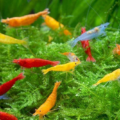
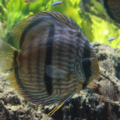
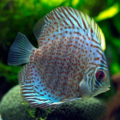
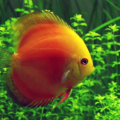
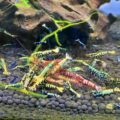
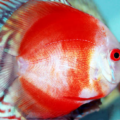
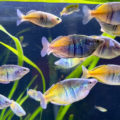
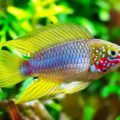
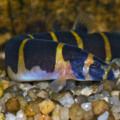
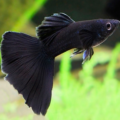
1 thought on “Blue Diamond Discus: The Ultimate Guide to Care, Tank Setup, and Compatibility”